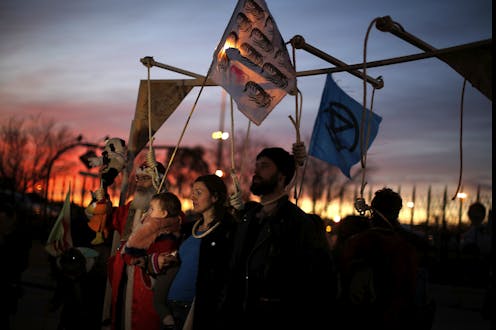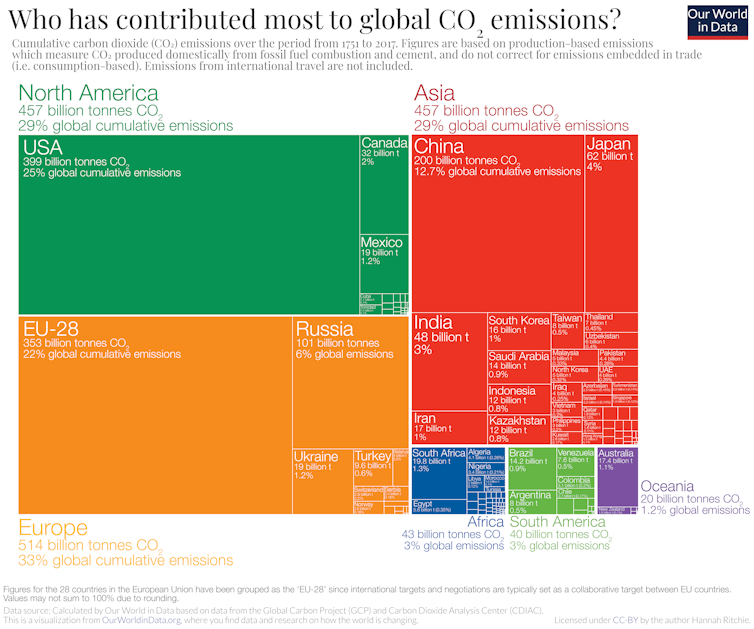The Madrid climate conference's real failure was not getting a broad deal on global carbon markets
Activists wanted nations to make bigger climate commitments at the Madrid COP-25 meeting, but the meeting's real goal was agreeing on rules for pricing carbon pollution.

Press accounts of the Madrid climate conference that adjourned on Dec. 15 are calling it a failure in the face of inspirational calls from youth activists and others for greater ambition. But based on my 25 years following and analyzing this process together with scholars and government officials from around the world, I believe the reality is more complicated.
True, this round of climate talks did not produce an aspirational statement calling for greater ambition in the next round of national pledges. In my view, that’s not actually very significant in terms of its real effects, even though organizations such as Greenpeace and Extinction Rebellion framed this as the key task for this meeting.
On the other hand, the talks failed to reach one of their key stated goals: writing meaningful rules to help facilitate global carbon markets. As an economist, I see this as a real disappointment – although not the fatal failure some portray it to be.
Tackling the free-rider problem
Here’s some context to explain why international cooperation is essential to tackle climate change. Regardless of where they’re emitted, greenhouse gases mix in the atmosphere. That’s different from other air pollutants, which can affect localities or large areas, but not the entire world.
This means that any jurisdiction that reduces its emissions incurs all of the costs of doing so, but receives only a share of the global benefits. Everyone has an incentive to free-ride, relying on others to cut emissions while taking minimal steps themselves.
Recognizing this problem, nations adopted the United Nations Framework Convention on Climate Change at the Rio Earth Summit in 1992. As with many other international treaties, member countries agreed to hold regular meetings to devise rules for achieving the goals set out in the agreement. That’s how the Conference of Parties, or COP, process was launched.
Why climate change is a wicked problem
If the pace of progress at these meetings seems slow, keep in mind three factors that make their task enormously challenging.
First, every nation has an incentive to exploit the atmosphere and rely on other countries to cut emissions.
Second, making reductions costs money up front – but since carbon dioxide emissions remain in the atmosphere and warm the Earth for up to a century, many of the benefits of cutting emissions accrue much later.
Third, the costs of cutting emissions fall on particular sectors – notably, fossil fuel interests – that have a strong monetary incentive to fight back. But the benefits are broadly distributed across the general public. Some people care passionately about this issue, while others give it little thought.
At the COP-1 meeting in 1995 in Berlin, members decided that some of the wealthiest countries would commit to targets and timetables for emission reductions, but there would be no commitments for other countries. Two years later, nations adopted the Kyoto Protocol, which set quantitative targets only for Annex I (largely wealthy) countries.
That wasn’t a broad enough foundation to solve the climate challenge. Annex I countries alone could not reduce global emissions, since the most significant growth was coming from large emerging economies – China, India, Brazil, Korea, South Africa, Mexico and Indonesia – that were not part of the Annex I group.
Everybody in
At negotiations in 2009 in Copenhagen and 2010 in Cancun, distinctions between wealthy and developing countries began to blur. This culminated in an agreement at Durban, South Africa, in 2011 that all countries would come under the same legal framework in a post-Kyoto agreement, to be completed in 2015 in Paris.
The Paris Agreement provided a promising, fresh approach. It proposed a bottom-up strategy in which all 195 participating countries would specify their own targets, consistent with their national circumstances and domestic political realities.
This convinced many more nations to sign up. Countries that joined the Paris Agreement represented 97% of global greenhouse gas emissions, compared to 14% currently under the Kyoto Protocol. But it also gave every country an incentive to minimize its own actions while benefiting from other nations’ reductions. It is worth noting that China overtook the United States in 2006 as the world’s largest annual emitter of greenhouse gases, but the U.S. remains the largest historical contributor to the accumulated stock of GHGs in the atmosphere.

Growing carbon markets
Are there ways to persuade nations to increase their commitments over time? One key strategy is linking national policies, so that emitters can buy and sell carbon emissions allowances or credits across borders.
For example, California and Quebec have linked their emissions trading systems. On Jan. 1, 2020, the European Union and Switzerland will do likewise.
Note, however, that such linking need not be restricted to pairs of cap-and-trade systems. Rather, heterogeneous linkage among cap-and-trade, carbon taxes and performance standards is perfectly feasible.
Expanding carbon markets in this way lowers costs, enabling countries to be more ambitious. One recent study estimates that linkage could, in theory, reduce compliance costs by 75%.
But for such systems to be meaningful, each country’s steps must be correctly counted toward its national target under the Paris Agreement. This is where Article 6 of the Paris Agreement comes in. Writing the rules for this article was the primary task for negotiators in Madrid (28 other articles were completed at the 2018 COP in Katowice, Poland).
Unfortunately, Brazil, Australia and a few other countries insisted on adopting accounting loopholes that made it impossible to reach agreement in Madrid on Article 6. Negotiators had an opportunity to define clear and consistent guidance for accounting for emissions transfers but failed to close a deal.
But if they had adopted guidance that extended much beyond basic accounting rules, as some countries wanted, the result could have been restrictive requirements that would actually impede effective linkage. This would have made it more expensive, not less, for nations to achieve their Paris targets. As Teresa Ribera, minister for the Ecological Transition of Spain, observed at COP-25, “No deal is better than a bad deal” on carbon markets and Article 6.
The baton for completing Article 6 has been passed to COP-26 in Glasgow in November 2020. In the meantime, without agreement on an overall set of rules, countries may develop their own rules for international linkages that can foster high-integrity carbon markets, as California, Quebec, the European Union and Switzerland already have. If negotiators can keep their eyes on the prize and resist being diverted by demands from activists and interest groups, I believe real success is still possible.
Robert Stavins has served as a consultant on the design of cap-and-trade systems for the Western States Petroleum Association. The work of the Harvard Environmental Economics Program and the Harvard Project on Climate Agreements have received funding from a variety of foundations, which are listed on the respective websites. Stavins is a member of the Board of Directors of Resources for the Future.
Read These Next
From truce in the trenches to cocktails at the consulate: How Christmas diplomacy seeks to exploit s
World leaders like to talk up peace at Christmastime. But alongside the tales of seasonal breaks in…
How to reduce gift-giving stress with your kids – a child psychologist’s tips for making magic and a
Depending on family circumstances and a child’s personality type, gift giving runs the gamut of fun…
The world risks forgetting one of humanity’s greatest triumphs as polio nears global eradication − 7
Polio may finally be defeated in the next 5 years. Will the world recognize what an extraordinary achievement…






